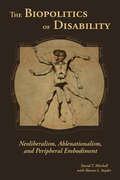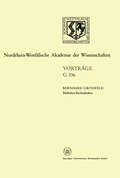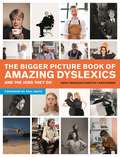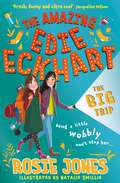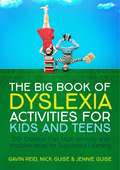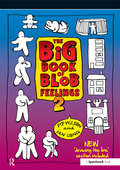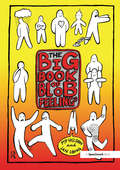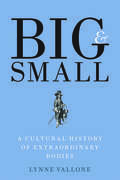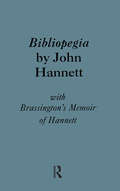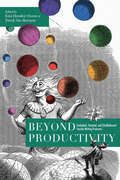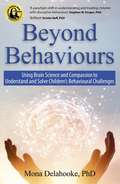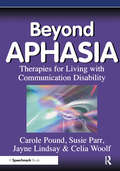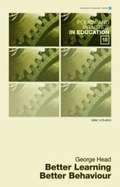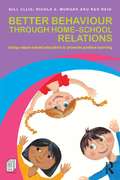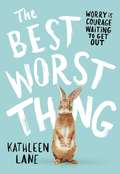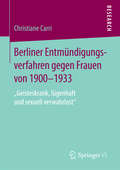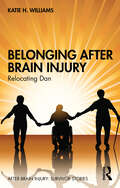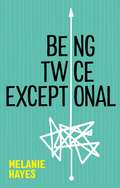- Table View
- List View
The Biopolitics of Disability: Neoliberalism, Ablenationalism, and Peripheral Embodiment (Corporealities: Discourses Of Disability)
by David T. MitchellIn the neoliberal era, when human worth is measured by its relative utility within global consumer culture, selected disabled people have been able to gain entrance into late capitalist culture. The Biopolitics of Disability terms this phenomenon “ablenationalism” and asserts that “inclusion” becomes meaningful only if disability is recognized as providing modes of living that are alternatives to governing norms of productivity and independence. Thus, the book pushes beyond questions of impairment to explore how disability subjectivities create new forms of embodied knowledge and collective consciousness. The focus is on the emergence of new crip/queer subjectivities at work in disability arts, disability studies pedagogy, independent and mainstream disability cinema (e.g., Midnight Cowboy), internet-based medical user groups, anti-normative novels of embodiment (e.g., Richard Powers’s The Echo-Maker) and, finally, the labor of living in “non-productive” bodies within late capitalism.
Bildhaftes Rechtsdenken: Recht als bejahte Ordnung (Nordrhein-Westfälische Akademie der Wissenschaften #336)
by Bernhard GroßfeldThe Bigger Picture Book of Amazing Dyslexics and the Jobs They Do
by Kate Power Kathy Iwanczak ForsythA beautifully designed book (packed with photos) full of wise words and encouragement from successful dyslexics working in comedy, architecture, law, fashion and many other amazing (and achievable!) careers.Honest about the challenges of dyslexia (like problems or embarrassment at school), while showing how its strengths can be used to your advantage (for example how visualising and big picture thinking can make you shine at work), this is a book of colourful conversations with creative, motivated and successful people who are brilliant at what they do, and who achieve incredible things because of their dyslexia. There is also a section from people working to support people with dyslexia, who have researched the subject or work directly helping dyslexics on a day to day basis, who they share their top tips and advice gleaned from their years of experience.Read on to gain encouragement and inspiration in your own careers!
The Big Trip: Book 2 (The Amazing Edie Eckhart #2)
by Rosie JonesFrom TV comedian Rosie comes a sparky and HILARIOUS series for readers aged 9+. Perfect for fans of Jacqueline Wilson and DORK DIARIES.'Fresh, funny and ultra cool' - Jacqueline WilsonHi! I'm Edie Eckhart. I'm a little bit different. I have a disability called cerebral palsy, so I talk slowly and fall over a lot. It's never really bothered me because I've never known anything else. This term, Edie Eckhart has A LOT on her mind:'Why am I the only one who doesn't know what to be when I grow up? Why am I the only one worried about going on the school drama trip? And why am I the only one who thinks eating 21 Brussels sprouts at once is YUMMY?' Life's confusing questions are making Edie wonder if she REALLY knows who she REALLY is. Will Edie realise it's OK not to have ALL the answers ALL of the time ... and just BE EDIE?
The Big Book of Dyslexia Activities for Kids and Teens: 100+ Creative, Fun, Multi-sensory and Inclusive Ideas for Successful Learning
by Gavin Reid Nick Guise Jennie GuisePacked with fun, creative and multi-sensory activities, this resource will help children and teenagers with dyslexia become successful learners across the curriculum.The authors provide over one hundred tried-and-tested fun and imaginative activities and ideas to unlock the learning of children and teenagers with dyslexia in creative ways. The book is split into parts addressing literacy, numeracy, learning and cross curricular subjects. With fun activities like 'Spelling Ping-Pong' and 'Class Got Talent', it focuses on key skills such as listening, memory, spelling, writing and key board skills.Each activity includes a 'red herring' that will keep dyslexic children and teenagers entertained, extending them in interesting ways that will appeal to those who think outside of the box. Brimming with imaginative ideas, The Big Book of Dyslexia Activities is an essential toolkit for any teacher or parent working with children and young people with dyslexia.
The Big Book of Dyslexia Activities for Kids and Teens: 100+ Creative, Fun, Multi-sensory and Inclusive Ideas for Successful Learning
by Gavin Reid Nick Guise Jennie GuisePacked with fun, creative and multi-sensory activities, this resource will help children and teenagers with dyslexia become successful learners across the curriculum.The authors provide over one hundred tried-and-tested fun and imaginative activities and ideas to unlock the learning of children and teenagers with dyslexia in creative ways. The book is split into parts addressing literacy, numeracy, learning and cross curricular subjects. With fun activities like 'Spelling Ping-Pong' and 'Class Got Talent', it focuses on key skills such as listening, memory, spelling, writing and key board skills.Each activity includes a 'red herring' that will keep dyslexic children and teenagers entertained, extending them in interesting ways that will appeal to those who think outside of the box. Brimming with imaginative ideas, The Big Book of Dyslexia Activities is an essential toolkit for any teacher or parent working with children and young people with dyslexia.
The Big Book of Blob Feelings: Book 2
by Pip Wilson Ian LongA special selection of photocopiable blob pictures designed for work on feelings. Arranged into four sections, the contents include: Blob Theory - Blob trees the id/ego/superego, needs, shadows | Emotions - anger, anger cycle, calm, depression, disappointed, happy, hate, hyper, jealousy, lonely, mixed-up, numb, paranoia, rejection, sad, trauma, worry | Developmental/issues - bridge, clouds, doors, feelings, holes, pit, pitch, stairs, families, home. Each picture is accompanied by ideas and questions to kick start class, group or one-to-one discussion. Complete book included on accompanying CD Rom.
Big Book of Blob Feelings (Blobs)
by Pip Wilson Ian LongThe Big Book of Blob Feelings uses questions linked to specially selected, photocopiable pictures to help you explore feelings with those who struggle to communicate about their emotions. Tried, tested and loved internationally, this inspirational resource includes a wealth of material around: Blob Theory - the feelosophy, our open-question approach and the importance of allowing people to express their choices freely; Emotions - every day we all experience a wide range of feelings, a broad selection of which have been illustrated to kick-start discussions; Developmental issues - the objective of each of the sheets is to see people of all ages grow in their awareness of who they are, their uniqueness, and how they can develop those gifts further as they share with others. Each picture is accompanied by ideas and questions to kick-start class, group or one-to-one discussion so that everything in the book is relevant to your needs in your setting. The complete book is also included electronically on the accompanying CD Rom so that you can print and re-use resources as often as you need to. The perfect companion to this book is The Big Book of Blob Feelings 2, which provides a huge range of new material while following the same structure and approach.
Big and Small: A Cultural History of Extraordinary Bodies
by Lynne ValloneA groundbreaking work that explores human size as a distinctive cultural marker in Western thought Author, scholar, and editor Lynne Vallone has an international reputation in the field of child studies. In this analytical tour-de-force, she explores bodily size difference—particularly unusual bodies, big and small—as an overlooked yet crucial marker that informs human identity and culture. Exploring miniaturism, giganticism, obesity, and the lived experiences of actual big and small people, Vallone boldly addresses the uncomfortable implications of using physical measures to judge normalcy, goodness, gender identity, and beauty. This wide-ranging work surveys the lives and contexts of both real and imagined persons with extraordinary bodies from the seventeenth century to the present day through close examinations of art, literature, folklore, and cultural practices, as well as scientific and pseudo-scientific discourses. Generously illustrated and written in a lively and accessible style, Vallone’s provocative study encourages readers to look with care at extraordinary bodies and the cultures that created, depicted, loved, and dominated them.
Bibliopegia
by John Hannett W. S. BrassingtonA part of the history of bookbinding collection-A series of reprint volumes, original monographs, and translations relating to the history of bookbinding. This volume includes a Bibliopegia of bookbinding in two parts- The ‘Books of the Ancients and History of the Art of Bookbinding’. and in part two, ‘The practical art of bookbinding’. This edition includes Brassington’s memoir of Hammett.
Bibliopegia: Or The Art Of Bookbinding, In All Its Branches (Cambridge Library Collection - History Of Printing, Publishing And Libraries Ser.)
by John Hannett W. S. BrassingtonA part of the history of bookbinding collection-A series of reprint volumes, original monographs, and translations relating to the history of bookbinding. This volume includes a Bibliopegia of bookbinding in two parts- The ‘Books of the Ancients and History of the Art of Bookbinding’. and in part two, ‘The practical art of bookbinding’. This edition includes Brassington’s memoir of Hammett.
Beyond Productivity: Embodied, Situated, and (Un)Balanced Faculty Writing Processes
by Kim Hensley Owens Derek Van IttersumIn Beyond Productivity, a wide range of contributors share honest narratives of the sometimes-impossible conditions that scholars face when completing writing projects. The essays provide backstage views of the authors' varying approaches to moving forward when the desire to produce wanes, when deciding a project is not working, when working within and around and redefining academic productivity expectations, and when writing with ever-changing bodies that do not always function as expected. This collection positions scholarly writers' ways of writing as a form of flexible, evolving knowledge. By exhibiting what is lost and gained through successive rounds of transformation and adaptation over time, the contributors offer a sustainable understanding and practice of process—one that looks beyond productivity as the primary measure of success. Each presents a fluid understanding of the writing process, illustrating its deeply personal nature and revealing how fragmented and disjointed methods and experiences can highlight what is precious about writing. Beyond Productivity determines anew the use and value of scholarly writing and the processes that produce it, both within and beyond the context of the losses, constraints, and adaptations associated with the COVID-19 pandemic.
Beyond Behaviours: Using Brain Science and Compassion to Understand and Solve Children's Behavioural Challenges
by Mona DelahookeA PARADIGM SHIFT FOR CAREGIVERS THAT WILL REVOLUTIONIZE THE WAY YOU APPROACH, TREAT OR PARENT A CHILD WITH CHALLENGING OR EXPLOSIVE BEHAVIOURS. When you are confronted with a child who is troubled, disruptive, oppositional, defiant or angry - whether you are a parent or a teacher - it can be difficult to know the best way to support them. Traditional methods of 'shaping' a child's behaviour can often be at best ineffective, at worst distressing, for child and adult alike.Drawing on 30 years of experience, internationally known paediatric psychologist Dr Mona Delahooke describes these troubled behaviours as the 'tip of the iceberg', important signals that point to deeper, individual differences in the child that we need to understand and address before we can resolve behavioural challenges. Using the very latest neuroscientific research Beyond Behaviours makes the case that many children who can't seem to behave simply don't have the developmental capacity to do so - yet. This book uses neuroscientific findings to help you deconstruct behaviour challenges, and to discover their cause and triggers for your child. It will show you how to apply this knowledge across a variety of behaviour spectrums, from children diagnosed with autism or other forms of neurodiversity, to those who might have been exposed to toxic stress or trauma during their early years. There are practical strategies to implement at every stage, backed up by impactful worksheets and charts, with a strong emphasis not on 'managing' behaviour, but instead on helping children and families build positive experiences to counteract the stress and pressure felt by everybody when you're working, or living, with a child who has behavioural challenges. Accessible, practical, warmly supportive and steeped in research and clinical expertise, Beyond Behaviours offers a break-through book which guides us - parents and caregivers alike - to the realisation that the most important tool in our toolkit is always our connection with the child standing in front of us.
Beyond Aphasia: Therapies For Living With Communication Disability (Speechmark Editions)
by Carole Pound Susie Parr Jayne Lindsay Celia WoolfThis book focuses explicitly on therapeutic techniques developed from a social model approach to disability and learning to live with difference. It describes theories, activities and methods of implementation developed from the work of Connect with people with long term aphasia. "Theoretical discussion runs alongside practical ideas for therapy and evaluation, case studies and commentaries from the authors regarding the method and means of implementation." Synthesises theory and practice in this new area of service delivery. Its non-impairment led focus of the therapies means that it has wide appeal to therapists, health service professionals and volunteers who work with people with chronic disabilities affecting lifestyle and communication.
Beyond Aphasia: Therapies For Living With Communication Disability (Speechmark Editions)
by Carole Pound Susie Parr Jayne Lindsay Celia WoolfThis book focuses explicitly on therapeutic techniques developed from a social model approach to disability and learning to live with difference. It describes theories, activities and methods of implementation developed from the work of Connect with people with long term aphasia. "Theoretical discussion runs alongside practical ideas for therapy and evaluation, case studies and commentaries from the authors regarding the method and means of implementation." Synthesises theory and practice in this new area of service delivery. Its non-impairment led focus of the therapies means that it has wide appeal to therapists, health service professionals and volunteers who work with people with chronic disabilities affecting lifestyle and communication.
Better Learning, Better Behaviour (Policy And Practice In Education Ser. (PDF) #18)
by George HeadGeorge Head explores the issues surrounding young people experiencing social, emotional and behavioural difficulties (SEBD) and suggests teaching strategies that, in targeting such children work to the benefit of all at school. Furthermore, the book argues that, within a context of inclusion, provision for pupils regarded as belonging to the category requires to be refocused onto their learning rather than their behaviour. The focus of educational policy has become increasingly rights based and conflicts arise from, for example, the right of children with SEBD to be taught alongside their peers as against the right of the majority of pupils to learn without the disruption caused by inappropriate behaviour. Through a critical examination of theories of behaviour and learning, recent policy and research, the book argues that traditional approaches that focus on young people’s behaviour have been inadequate and have led to the marginalisation of children and their teachers. These traditional approaches have led to the construction of pupil and teacher identities that are based on personal and professional deficit thus reinforcing views that segregated provision is the most appropriate educational context for this group. Instead, the author argues that a shift in practice that is posited on optimistic theories of behaviour and adopts a focus on learning rather than behaviour will help create the identities of effective learner and teacher that will enhance the educational experience of all young learners in schools. Intended as a textbook for student teachers and a reference for those involved in teaching young people with social, emotional or behavioural difficulties this analysis will appeal wherever schools grapple with these problems Dr George Head is a senior lecturer in the Department of Educational Studies, Faculty of Education, University of Glasgow.
Better Behaviour through Home-School Relations: Using values-based education to promote positive learning
by Gill Ellis Nicola S. Morgan Ken ReidHow can we create effective partnerships between home, school and the community? How can the relationships and communication between families and school be strengthened? How can families help schools to improve behaviour in their children, both at home and at school? Using a tried and tested framework that has been successfully implemented throughout a wide variety of very different schools and settings, ‘Family Values’ is a Scheme which engages and empowers families to work in close collaboration with schools and organisations, and which results in long-term improvements in behaviour, communication, pupil achievement and relationships. The ‘Family Values’ Scheme has been proven to: Help pupils to be more academically diligent Help schools to assume a calmer, more peaceful ambience Forge better pupil-teacher relationships Improve Pupil and teacher wellbeing Help parents to be more engaged with the school Improve children’s literacy, behaviour and attendance Provide head teachers and their staff with an effective whole-school strategy. The authors’ award-winning ‘Family Values’ Scheme is underpinned by sound theoretical principles, and they show here how it has been successfully put into practice through case studies in real school settings. The book explores how the Scheme promotes social, emotional and family system theories, and, in linking effectively to SEAL (social and emotional aspects of learning), the Scheme compliments existing personal and social education programmes in all schools. Showing schools and organisations how to create effective partnerships with families and the community in a fun, exciting and sustainable way, Better Behaviour through Home-School Relations will be of huge benefit to all school staff, as well as local authorities, support groups, parents, charities and services.
Better Behaviour through Home-School Relations: Using values-based education to promote positive learning
by Gill Ellis Nicola S. Morgan Ken ReidHow can we create effective partnerships between home, school and the community? How can the relationships and communication between families and school be strengthened? How can families help schools to improve behaviour in their children, both at home and at school? Using a tried and tested framework that has been successfully implemented throughout a wide variety of very different schools and settings, ‘Family Values’ is a Scheme which engages and empowers families to work in close collaboration with schools and organisations, and which results in long-term improvements in behaviour, communication, pupil achievement and relationships. The ‘Family Values’ Scheme has been proven to: Help pupils to be more academically diligent Help schools to assume a calmer, more peaceful ambience Forge better pupil-teacher relationships Improve Pupil and teacher wellbeing Help parents to be more engaged with the school Improve children’s literacy, behaviour and attendance Provide head teachers and their staff with an effective whole-school strategy. The authors’ award-winning ‘Family Values’ Scheme is underpinned by sound theoretical principles, and they show here how it has been successfully put into practice through case studies in real school settings. The book explores how the Scheme promotes social, emotional and family system theories, and, in linking effectively to SEAL (social and emotional aspects of learning), the Scheme compliments existing personal and social education programmes in all schools. Showing schools and organisations how to create effective partnerships with families and the community in a fun, exciting and sustainable way, Better Behaviour through Home-School Relations will be of huge benefit to all school staff, as well as local authorities, support groups, parents, charities and services.
The Best Worst Thing
by Kathleen LaneFront door locked, kitchen door locked, living room windows closed.Nobody in the closet, nobody under the beds.Still, Maggie is worried. Ever since she started middle school, she sees injustice and danger everywhere--on the news, in her textbooks, in her own neighborhood. Even her best friend seems to be changing. Maggie believes it is up to her, and only her, to make everything all right. Can she come up with a plan to keep everyone safe?The Best Worst Thing is a perceptive novel about learning the limits of what you can control, and the good--sometimes even best--things that can come of finally letting go.
Berliner Entmündigungsverfahren gegen Frauen von 1900-1933: „Geisteskrank, lügenhaft und sexuell verwahrlost“
by Christiane CarriChristiane Carris zentrales Anliegen ist es, die Verschränkungen von Sexualität und Geschlecht in ihrer juristisch-medizinischen Machtdimension zu Beginn des 20. Jahrhunderts zu hinterfragen. Dafür rückt die Autorin die psychiatrischen Gutachten der Gerichtsakten Berliner Entmündigungsverfahren in den Jahren 1900–1933 in den Mittelpunkt ihrer Analyse. Die juristischen Quellen zu ‚weiblichem Wahnsinn‘ sind im deutschsprachigen Raum bislang unbeachtet geblieben und werden im Zuge dieses Buches auf unterschiedlichsten Wegen untersucht. Konzepte von Geisteskrankheit und die Kategorisierungen des Wahnsinns im psychiatrischen Diskurs sowie die Konstruktionen geschlechtlicher Identität werden herausgearbeitet.
Ben the Bubble Bear: Targeting the b Sound (Speech Bubbles 1)
by Melissa PalmerBen the bear loves to blow bubbles, but what happens when he tries to blow the biggest bubble in the world? This picture book targets the /b/ sound, and is part of Speech Bubbles 1, a series of picture books that target specific speech sounds within the story. The series can be used for children receiving speech therapy, for children who have a speech sound delay/disorder, or simply as an activity for children’s speech sound development and/or phonological awareness. They are ideal for use by parents, teachers or caregivers. Bright pictures and a fun story create an engaging activity perfect for sound awareness. Please see other titles in the series for stories targeting other speech sounds.
Ben the Bubble Bear: Targeting the b Sound (Speech Bubbles 1)
by Melissa PalmerBen the bear loves to blow bubbles, but what happens when he tries to blow the biggest bubble in the world? This picture book targets the /b/ sound, and is part of Speech Bubbles 1, a series of picture books that target specific speech sounds within the story. The series can be used for children receiving speech therapy, for children who have a speech sound delay/disorder, or simply as an activity for children’s speech sound development and/or phonological awareness. They are ideal for use by parents, teachers or caregivers. Bright pictures and a fun story create an engaging activity perfect for sound awareness. Please see other titles in the series for stories targeting other speech sounds.
Belonging After Brain Injury: Relocating Dan (After Brain Injury: Survivor Stories)
by Katie H. WilliamsBelonging After Brain Injury: Relocating Dan explores the life of the author’s brother who has dealt with the effects of a severe traumatic brain injury (TBI) for over four decades. It recounts the institutional, psychological, and social labyrinths he and his family have navigated following the TBI he sustained at the age of eighteen. This insightful volume offers a holistic account of the impact of TBI on the survivor and his family. It reveals the difficulties a TBI survivor has had to endure and provides practical information about physical, psychological, and psychosocial symptoms and their consequences. Dan’s story offers new perspectives and strategies that will help alleviate seemingly intractable problems and highlights the central importance of forming connections with others in order to lead a fuller life. The author’s account of her own journey, learning to help care for and advocate for Dan, offers an invaluable guide for TBI survivors and those who care for and support them. Belonging After Brain Injury: Relocating Dan will be of interest to TBI survivors and their families. Its rich insights will be essential reading for medical and mental health professionals, as well those involved in the care and rehabilitation of TBI survivors and families.
Belonging After Brain Injury: Relocating Dan (After Brain Injury: Survivor Stories)
by Katie H. WilliamsBelonging After Brain Injury: Relocating Dan explores the life of the author’s brother who has dealt with the effects of a severe traumatic brain injury (TBI) for over four decades. It recounts the institutional, psychological, and social labyrinths he and his family have navigated following the TBI he sustained at the age of eighteen. This insightful volume offers a holistic account of the impact of TBI on the survivor and his family. It reveals the difficulties a TBI survivor has had to endure and provides practical information about physical, psychological, and psychosocial symptoms and their consequences. Dan’s story offers new perspectives and strategies that will help alleviate seemingly intractable problems and highlights the central importance of forming connections with others in order to lead a fuller life. The author’s account of her own journey, learning to help care for and advocate for Dan, offers an invaluable guide for TBI survivors and those who care for and support them. Belonging After Brain Injury: Relocating Dan will be of interest to TBI survivors and their families. Its rich insights will be essential reading for medical and mental health professionals, as well those involved in the care and rehabilitation of TBI survivors and families.
Being Twice Exceptional
by Melanie HayesTwice exceptionality (2e) is not well understood. While many parents, educators, and professionals are working to bridge the knowledge gap and help 2e children, there is still a great deal we do not know about how life turns out for those children once they grow up.How do 2e adults deal with the complex aspects of being an adult? What are your prospects if you are brilliant, but can't get into college? What if you fail at work because you don't know how to fit in socially? This book provides first-hand stories about the experiences of 2e adults, offering compassionate coping strategies for overcoming and rethinking the tough parts. It champions radical acceptance of 2e people and celebrates their unique outlook on the world.
